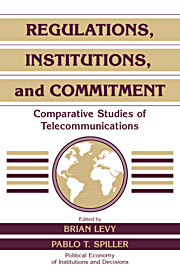Book contents
- Frontmatter
- Contents
- Foreword
- Series editor's preface
- Preface
- List of contributors
- 1 A framework for resolving the regulatory problem
- 2 Telecommunications regulation in Jamaica
- 3 The United Kingdom: A pacesetter in regulatory incentives
- 4 Chile: Regulatory specificity, credibility of commitment, and distributional demands
- 5 The political economy of the telecommunications sector in the Philippines
- 6 Argentina: The sequencing of privatization and regulation
- Notes
- References
- Index
4 - Chile: Regulatory specificity, credibility of commitment, and distributional demands
Published online by Cambridge University Press: 05 June 2012
- Frontmatter
- Contents
- Foreword
- Series editor's preface
- Preface
- List of contributors
- 1 A framework for resolving the regulatory problem
- 2 Telecommunications regulation in Jamaica
- 3 The United Kingdom: A pacesetter in regulatory incentives
- 4 Chile: Regulatory specificity, credibility of commitment, and distributional demands
- 5 The political economy of the telecommunications sector in the Philippines
- 6 Argentina: The sequencing of privatization and regulation
- Notes
- References
- Index
Summary
Chile's experiments with regulatory regimes and ownership patterns in telecommunications have produced radically different results. Between 1930 and 1970 firms were privately owned and regulated but the sector grew only modestly after the agreed investment obligations were fulfilled. In the 1970s the government took over ownership of the two firms providing local and long-distance services and ran them as regulated monopolies. The sector grew even slower than before. Beginning in 1982 Chile deregulated some segments of the sector, improved regulation of others, and returned the firms to private ownership. The gains have been substantial: The number of new lines doubled in four years, unmet demand has declined, new services are being introduced, and modern technology is replacing old. Why has this latest episode been so much more successful than the others?
Chile's experience shows how the proper match of regulatory regime and political institutions can foster efficient development of the telecommunications sector. Though regulatory incentive structures have been important (pricing, entry), more important have been the distributional demands of various interest groups and the effect of institutional factors on the credibility of government commitment not to behave opportunistically.
Three questions guide the analysis:
How clearly did the different regulatory regimes spell out pricing rules, entry policy, and conflict-resolution mechanisms?
Did these different regulatory regimes equally persuade firms to invest in the sector and operate efficiently?
[…]
- Type
- Chapter
- Information
- Regulations, Institutions, and CommitmentComparative Studies of Telecommunications, pp. 121 - 144Publisher: Cambridge University PressPrint publication year: 1996
- 5
- Cited by



